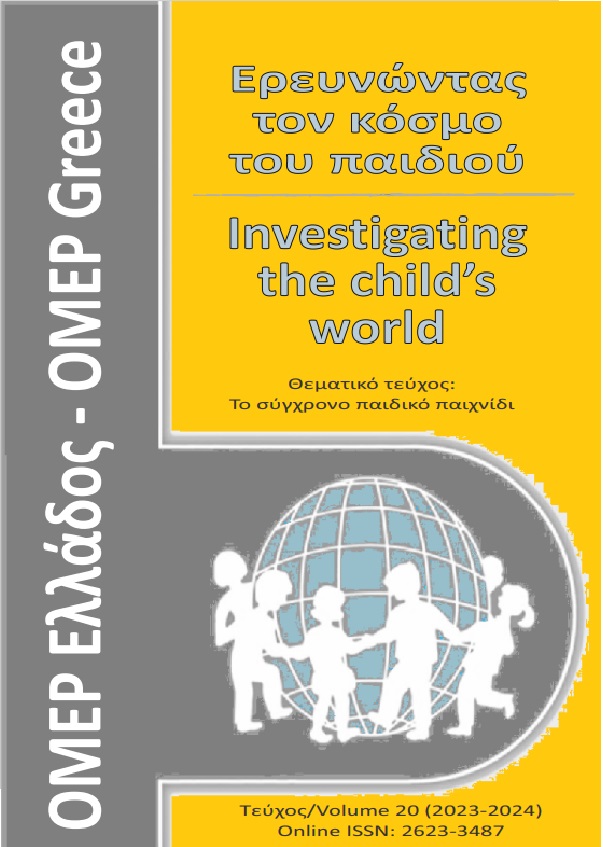Το μοναχικό παιχνίδι ως μέσο κοινωνικοποίησης και αυτονομίας του παιδιού προσχολικής ηλικίας
Resumen
Κυρίαρχη θέση στις αλληλεπιδράσεις του παιδιού έχει το παιχνίδι, ελεύθερο ή οργανωμένο. Ιδιαίτερα το ελεύθερο παιχνίδι προάγει την αποκέντρωση της σκέψης δημιουργώντας καταστάσεις προβληματισμού, οι οποίες ενθαρρύνουν την αποδοχή και τον σεβασμό του άλλου, αλλά και του εαυτού. Αυτό όμως που κάνει το παιδί να διαφέρει ως οντότητα μέσα στην ομάδα είναι το πώς ερμηνεύει και αντιλαμβάνεται την επιρροή των άλλων στη δική του πορεία. Έτσι, ακόμη κι αν ένα παιδί εμπλέκεται σε μοναχικό παιχνίδι βρίσκεται σε μια διαδικασία αξιολόγησης όσων βλέπει, μέχρι να φτάσει στο σημείο να εμπλακεί ενεργά σε αλληλεπίδραση με τους άλλους. Σκοπός της παρούσας έρευνας είναι η μελέτη του μοναχικού παιχνιδιού μέσα στα πλαίσια της ομάδας των συνομηλίκων ως μέσο κοινωνικοποίησης και αυτονομίας του παιδιού προσχολικής ηλικίας. Μέσω συμμετοχικής παρατήρησης που έλαβε χώρα σε τέσσερα νηπιαγωγεία σε προάστια του Παρισιού, και συνεντεύξεων με νηπιαγωγούς, αναδικνύεται ότι η ικανότητα του παιδιού να δραστηριοποιείται και να παίζει ελεύθερα μόνο του μέσα στο χώρο του νηπιαγωγείου, παρουσία άλλων ατόμων, του παρέχει τη δυνατότητα να πάρει πρωτοβουλίες και να δράσει αυτόνομα κάνοντας τις δικές του επιλογές. Έπειτα από ποιοτική ανάλυση πρωτογενούς υλικού, τα αποτελέσματα δείχνουν ότι τα παιδιά εμπλέκονται σε μοναχικό παιχνίδι για να συγκεντρωθούν στη δραστηριότητα που έχουν επιλέξει και να εξυπηρετήσουν τις προσωπικές τους ανάγκες, ενώ παράλληλα αναπτύσσουν κοινωνικές δεξιότητες διαπραγματεύοντας το ρόλο τους και τον χώρο τους μέσα στην ομάδα των συνομηλίκων.
Article Details
- Cómo citar
-
Αθανασοπούλου Ά. (2024). Το μοναχικό παιχνίδι ως μέσο κοινωνικοποίησης και αυτονομίας του παιδιού προσχολικής ηλικίας. Ερευνώντας τον κόσμο του παιδιού, 20, 21–33. https://doi.org/10.12681/icw.35406
- Sección
- Επιστημονική αρθρογραφία & εκπαιδευτικές δράσεις

Esta obra está bajo una licencia internacional Creative Commons Atribución-NoComercial 4.0.
Οι Συγγραφείς που δημοσιεύουν εργασίες τους σε αυτό το περιοδικό συμφωνούν στους παρακάτω όρους:
Οι Συγγραφείς διατηρούν τα Πνευματικά Δικαιώματα και χορηγούν στο περιοδικό το δικαίωμα της πρώτης δημοσίευσης ενώ ταυτόχρονα τα πνευματικά δικαιώματα της εργασίας προστατεύονται σύμφωνα με την Creative Commons Attribution License που επιτρέπει σε τρίτους - αποδέκτες της άδειας να χρησιμοποιούν την εργασία όπως θέλουν με την προϋπόθεση της διατήρησης των διατυπώσεων που προβλέπονται στην άδεια σχετικά με την αναφορά στον αρχικό δημιουργό και την αρχική δημοσίευση σε αυτό το περιοδικό.
Οι Συγγραφείς μπορούν να συνάπτουν ξεχωριστές, και πρόσθετες συμβάσεις και συμφωνίες για την μη αποκλειστική διανομή της εργασίας όπως δημοσιεύτηκε στο περιοδικό αυτό (π.χ. κατάθεση σε ένα ακαδημαϊκό καταθετήριο ή δημοσίευση σε ένα βιβλίο), με την προϋπόθεση της αναγνώρισης και την αναφοράς της πρώτης δημοσίευσης σε αυτό το περιοδικό.
Το περιοδικό επιτρέπει και ενθαρρύνει τους Συγγραφείς να καταθέτουν τις εργασίες τους μέσω διαδικτύου (π.χ. σε ένα ακαδημαϊκό καταθετήριο ή στους προσωπικές τους ιστοσελίδες) πριν και μετά από τις διαδικασίες της δημοσίευσης, καθώς αυτό μπορεί να οδηγήσει σε παραγωγική ανταλλαγή ιδεών και σκέψεων καθώς επίσης και σε γρηγορότερη και μεγαλύτερη χρήση και ευρετηρίαση της δημοσιευμένης εργασίας (See The Effect of Open Access).



